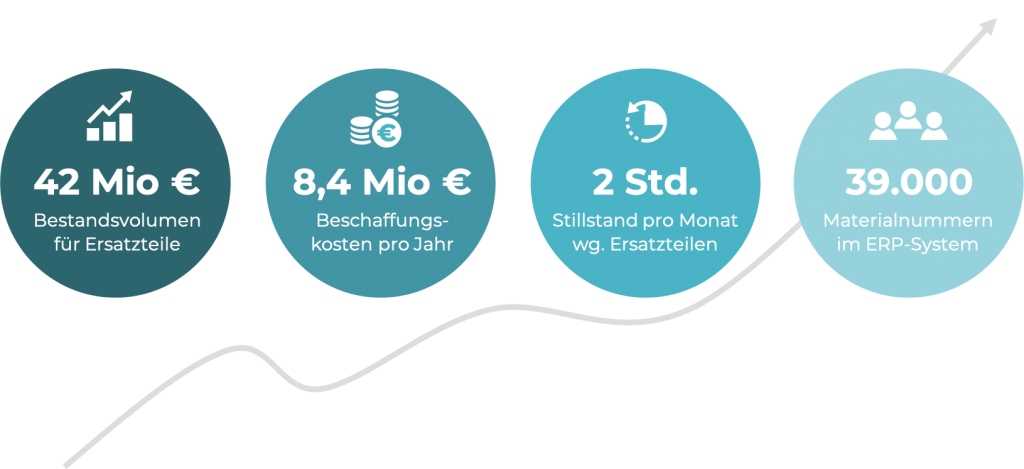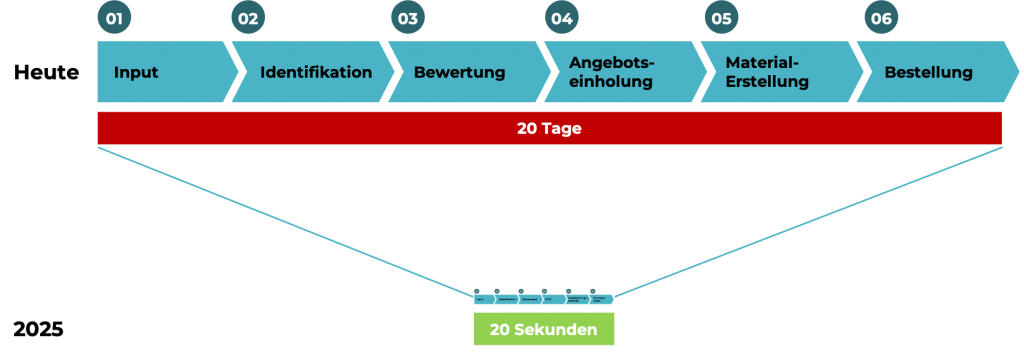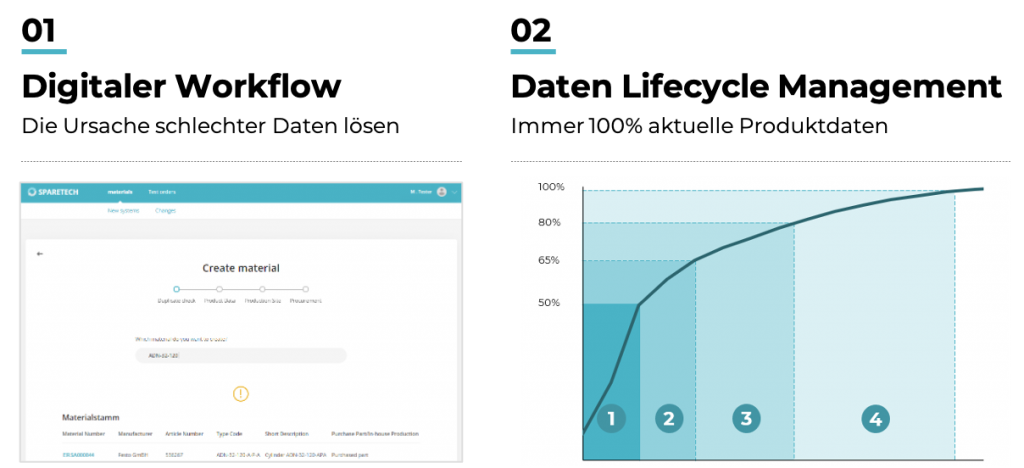
The main objective of maintenance management is to ensure the availability of plants and machines and to avoid unplanned plant downtimes. This is because the costs of unplanned downtimes, especially in highly automated and closely interlinked production processes, quickly amount to six-figure sums, or even more in the worst case.
It is particularly annoying when a repair is delayed because an urgently needed spare part is not available. When these problems occur, it is common practice for manufacturing companies to stock numerous different spare parts in their own warehouses.
From a maintenance perspective, this is a risk-minimizing preventive measure. From a business perspective, this means a lot of capital tied up. Analyses by SPARETECH show that the inventory volume for machine and plant spare parts of an automotive production plant amounts to € 42 million on average.
At the same time, the risk of machine downtime cannot be completely eliminated, as not all spare parts can be kept in stock due to the enormous variety of variants. On average, there are two hours of unplanned machine downtime every month due to a lack of spare parts. Particularly in emergencies, the procurement costs for spare parts increase. Along SPARETECH's automotive and consumer goods customers, an average of € 8.4 million is spent annually on procurement costs for machine and plant spare parts per site.

Why tackle spare parts management?
This article deals with the basic problems and causes as well as the solutions derived from them in order to increase plant availability and reduce the resulting procurement costs and factory costs.
Initial situation: equipment procurement
If a new plant is procured, the plant documentation is provided to the operator in advance of commissioning. This also includes the spare and wear parts lists for the respective plant sections, modules, assemblies and spare parts contained therein.
The work of maintenance planning on the part of the plant operator begins with the analysis of the spare parts list. Basically, this happens in five essential steps:
1. indexing of the list positions
2. stockpiling decision
3. request for quotation
4. new record creation in the system
5. procurement and goods receipt
1. indexing
In the first step of indexing, several challenges already arise. First, it is crucial to analyze which spare parts are meant in the list items of the present spare parts list. There are often discrepancies between the information in the list and that in the original manufacturer's specifications, especially with regard to part numbers, type designations and short texts. There are various reasons for this: However, since the spare parts lists are often still generated manually and are usually converted into customer-specific formats by hand, irregularities can occur.

Once the individual spare part items have been identified, it is important to be able to reliably detect duplicates within the list. In today's practice, methods such as Excel S-references taking into account deleted special characters are used for this purpose. It is obvious that this method does not work very reliably even with the smallest description differences, and in practice it often causes frustration among the people involved.
As soon as a best possible duplicate-free version of the existing spare parts list has been created, the comparison with the existing material numbers and the spare parts in the warehouse has to be carried out. This comparison is especially important to safely avoid the purchase of spare parts already in stock and to avoid duplicate stock.

The difficulty that presents itself in this step is that the descriptive texts of the spare parts list differ from the information in your own ERP system in almost every case. Only rarely are the designations, part numbers and description texts identical. Here, too, common methods such as Microsoft Excel reach their limits.
2. stockpiling decision
Once indexing has been completed, step 2 begins: the stockpiling decision. There are numerous, largely company-specific approaches to this, ranging from data-driven classification tools to purely expert assessments based on empirical values.
Classic methods such as ABC, XYZ classification are often used. Likewise, so-called risk priority numbers are determined by some companies to best support the decision at spare part and/or component level to stockpile. Common factors considered in a risk priority number are:
- Delivery time
- Price
- Number of layers
- estimated probability of default
- expected, future demand
In addition, in some cases the shift model is taken into account, as well as the storage costs or information on the shelf life.
The result of the stock assessment is ideally a duplicate-free list of spare parts to be procured that do not yet exist as material numbers and are not kept in stock. For list items that are already in stock, change proposals can be developed to adjust the MRP parameters for these materials, such as slightly increasing the safety stock.
3. request for quotation
The third step is to obtain a quote. Here, various options present themselves. On the one hand, all spare parts can be procured directly from the general contractor (so-called one-stop store). On the other hand, all offers can be obtained from the respective original manufacturer for the corresponding spare part. In this case, significantly more quotations have to be prepared, sent out and responses have to be given.
From a cost perspective, the best possible approach often lies in the golden mean. Machine-specific assemblies and spare parts are purchased directly from the machine manufacturer. On the other hand, it can make sense to bundle smaller components and procure them via wholesalers. Other components, for which framework agreements have already been negotiated with manufacturers, are best sourced directly.
4. new record creation in the system
Once the request for quotation has been successfully completed over a longer period of time, the new material data can be generated in the ERP system. In practice, numerous different practices can be found here: from manual entry in Excel, Access or Word input masks, to self-programmed or purchased add-ons, or the direct input mask in the ERP system.

Often, the existing solutions are not intuitive and cost the user a lot of time. In addition, all data must be manually transferred to the input forms, which opens up room for errors. The result is often incomplete, incorrect data records, which are then also difficult to find again using the existing search functions in the respective system. 9 out of 10 SPARETECH customers state that they waste too much time searching for spare parts in their own system - an average of 2.5 minutes per search process.
5. procurement and goods receipt
The next step is the procurement of the spare parts. The purchase requisition triggers the order via common purchasing transactions. After successful delivery and goods receipt inspection, the material numbers are stored, booked according to the storage locations and then wait to be used. Frequently, however, procured spare parts are never used because the assumed "demand forecast" in the course of the stockpiling decision was not accurate enough, so that at the end of the life cycle, spare parts that are not needed are often scrapped.
The costs for this amount to a sum in the six-digit range for an average automotive plant. At the same time, the ecological dimension is questionable, since functional spare parts are scrapped that were created with a high input of material, energy and capital.
The entire process from indexing to scrapping or consumption of the part at the end of its life cycle, is often 20 days in today's corporate practice, sometimes several months.
Digital Maintenance Management - With Software to Success
The described problems in spare parts management can be solved by using intelligent software. This reduces the total lead time from 20 days to just a few minutes.

SPARETECH offers this very digital and automated software solution to drastically reduce the high capital commitment costs, procurement costs and manual effort.
The web-based application essentially contains the two modules:
1. digital workflow and 2. data lifecycle management.

The digital workflow of SPARETECH includes both the single new creation of materials with verified manufacturer data from the SPARETECH database, as well as the automated spare parts list check (BOM check).
Data lifecycle management ensures the identification of all spare parts and duplicates in the material master and completes the data records with product and reference information. In the future, it will also be possible to continuously maintain product data through manufacturer updates (obsolescence management).
Across a wide range of customer groups, the Software-as-a-Service application has reduced inventory levels by up to 21% on average. At the same time, maintenance costs are significantly reduced.
Leading international companies such as Bosch, Porsche and Volkswagen already trust SPARETECH's digital solution and use it profitably in their daily operations.
Contact us to test the application for free and get a free quick check of your savings potential. We look forward to hearing from you.
__
Images: SPARETECH GmbH & Unsplash




